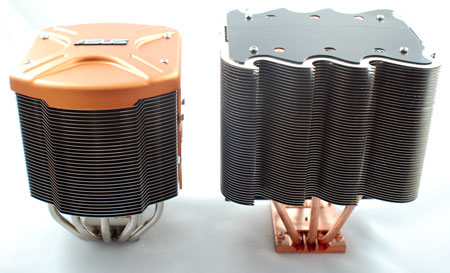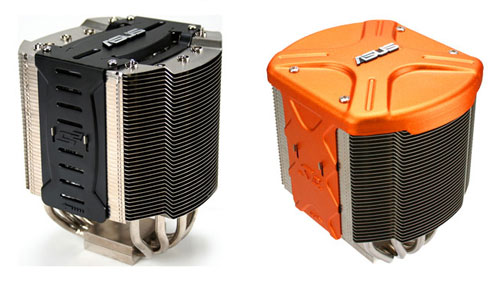ASUS Silent Square Pro: Compact Embedded-Fan Heatpipe Tower
by Wesley Fink on April 16, 2007 2:30 AM EST- Posted in
- Cases/Cooling/PSUs
Many of the tier-1 motherboard makers produce a large line of computer related parts and peripherals. This is not always well known to buyers around the world since these companies often produce some computer parts for the Asian market only. ASUS is one of the largest motherboard makers in the world, and they also produce cases and CPU coolers that are finally making their way to the US market.
The cooler line ranges from entry-level CPU coolers to heatpipe towers, like the ASUS Silent Square Pro being reviewed today. If you are not familiar with the ASUS cooler line you might be interested in checking out the cooler offerings at ASUS Thermal Solutions. Like the small Asian cars that began appearing in the US in the 1970's, the Silent Square claims it can do the same job as a bigger cooler in a much more compact and well-designed package.

The ASUS Silent Square Pro is a very interesting design in the top-of-the-line Silent Square series. It resembles the Tuniq Tower 120 in concept, in that the cooling fan is embedded in the center of the cooler with cooling fin arrays on both sides. However, the Silent Square uses a smaller 90mm fan compared to the standard 120mm fan used in the Tuniq. As you can see from the comparison photo this makes for a much smaller cooler than the Tuniq. The Tuniq Tower 120 is one of the best performing coolers tested at AnandTech, so the same idea in the smaller ASUS Silent Square Pro definitely generated some interest in our labs.

Silent Square is actually a series of two coolers at ASUS. The core of the Silent Square and the Silent Square Pro are basically the same. The Pro model adds a 2500 RPM fan instead of the 1800 RPM fan used in the Silent Square. Additionally, there is cladding that directs airflow and helps create a distinct appearance for the Pro version. The SS Pro also includes a fan controller that mounts in a 3.5" bay with a blue digital readout of the fan speed. It's a nice touch and a welcome way to vary fan speed.
S.Q.U.A.R.E.
Some readers are probably wondering why ASUS named this cooler the Silent Square since it is most certainly not square in shape. Square is actually an acronym and not a description in ASUS speak. The website defines the meaning and features of SQUARE:
Superior Performance for Overclockers
The Silent Square Pro incorporated a "wave-shaped" double side fin design on both sides of the cooler for larger heat exchange area.
Quick
Five copper heatpipes efficiently transfer heat to the fins, maintaining temperature for high-performance computing.
Universal Application
The Silent Square Pro supports the Intel Core 2 Extreme/Duo and other LGA775 CPUs as well as socket 478 processors; it also supports AMD socket 754/939/940/AM2 CPUs.
Aesthetics
Stylish wave-shaped fins for effective heat dissipation.
Reliable
The fan positioned inside the frame and VRM shield guide cool air to critical components around the CPU for stable operation.
Easy Installation
The patented retention module enables easy installation in three simple steps even without removing the motherboard from the system or memory modules from the board and regardless of the processor platform.
These features set a high bar for the ASUS Silent Square Pro. We have reviewed a number of air coolers that excel in performance for the overclocking enthusiast. Will the more compact ASUS Silent Square join the top ranks of Enthusiast coolers?
The cooler line ranges from entry-level CPU coolers to heatpipe towers, like the ASUS Silent Square Pro being reviewed today. If you are not familiar with the ASUS cooler line you might be interested in checking out the cooler offerings at ASUS Thermal Solutions. Like the small Asian cars that began appearing in the US in the 1970's, the Silent Square claims it can do the same job as a bigger cooler in a much more compact and well-designed package.

The ASUS Silent Square Pro is a very interesting design in the top-of-the-line Silent Square series. It resembles the Tuniq Tower 120 in concept, in that the cooling fan is embedded in the center of the cooler with cooling fin arrays on both sides. However, the Silent Square uses a smaller 90mm fan compared to the standard 120mm fan used in the Tuniq. As you can see from the comparison photo this makes for a much smaller cooler than the Tuniq. The Tuniq Tower 120 is one of the best performing coolers tested at AnandTech, so the same idea in the smaller ASUS Silent Square Pro definitely generated some interest in our labs.

Silent Square is actually a series of two coolers at ASUS. The core of the Silent Square and the Silent Square Pro are basically the same. The Pro model adds a 2500 RPM fan instead of the 1800 RPM fan used in the Silent Square. Additionally, there is cladding that directs airflow and helps create a distinct appearance for the Pro version. The SS Pro also includes a fan controller that mounts in a 3.5" bay with a blue digital readout of the fan speed. It's a nice touch and a welcome way to vary fan speed.
S.Q.U.A.R.E.
Some readers are probably wondering why ASUS named this cooler the Silent Square since it is most certainly not square in shape. Square is actually an acronym and not a description in ASUS speak. The website defines the meaning and features of SQUARE:
Superior Performance for Overclockers
The Silent Square Pro incorporated a "wave-shaped" double side fin design on both sides of the cooler for larger heat exchange area.
Quick
Five copper heatpipes efficiently transfer heat to the fins, maintaining temperature for high-performance computing.
Universal Application
The Silent Square Pro supports the Intel Core 2 Extreme/Duo and other LGA775 CPUs as well as socket 478 processors; it also supports AMD socket 754/939/940/AM2 CPUs.
Aesthetics
Stylish wave-shaped fins for effective heat dissipation.
Reliable
The fan positioned inside the frame and VRM shield guide cool air to critical components around the CPU for stable operation.
Easy Installation
The patented retention module enables easy installation in three simple steps even without removing the motherboard from the system or memory modules from the board and regardless of the processor platform.
These features set a high bar for the ASUS Silent Square Pro. We have reviewed a number of air coolers that excel in performance for the overclocking enthusiast. Will the more compact ASUS Silent Square join the top ranks of Enthusiast coolers?










24 Comments
View All Comments
Avalon - Tuesday, April 17, 2007 - link
Good review. Useless cooler.I'm still going to throw my vote out there for you guys possibly reviewing the Coolermaster HyperTX. That thing is supposed to cool extremely well while providing awesome mosfet cooling.
poohbear - Monday, April 16, 2007 - link
thanks for the review as heatsink reviews are always good to see! however, could u start using bar graphs in your reviews as they're MUCH easier to read then the ones u choose to use. Much simpler to view the info instead of sifting through all the names on the side and numbers on the right. please and thank u.Wesley Fink - Monday, April 16, 2007 - link
The bar graph idea sounds good, but the charts are trend line charts with 4 or 5 points for each cooler and fan configuration. It would take at least 5 bar graphs to replace each chart, and then the trend would also be lost. We have added a "click to enlarge" feature to the charts to make them more usable for those who closely scrutinize the temperature data.Frumious1 - Monday, April 16, 2007 - link
Every now and then some whiner will come along and dislike the scaling graphs, Wes. Just ignore them! Anyone that can't understand the intent of a scaling graph needs a lesson in reading comprehension anyway. My only thought is maybe some sorting of the data in the scaling graphs would be useful. They crurently seem to be sorted by when you reviewed the coolers, and most people probably could care less about the chronological aspects.At some point, you're going to need to start dropping coolers from those scaling graphs as well. That's my opinion at least - they're already very crowded! Maybe select the "best" coolers (or just a reasonable baseline group) and just leave those in the scaling graphs, with the complete list of coolers in the other charts? You could have the Thermalright Ultra 120 Extreme (is that out yet!?), Tuniq 120, Cooler Master Hyper 6+, Monsoon Lite II, Scythe Ninja B, and the lowly Intel retail. Then just add the specific cooler being tested. Right now there's definitely an "information overload" aspect ot the scaled charts, and it will only get worse with time as more HSFs are added.
/$0.02
strikeback03 - Monday, April 16, 2007 - link
Or possibly the best few coolers in each price bracket, along with the tested cooler, and a link to a large image of all of the tested coolers. Something interactive, where you could turn individual coolers on and off, whould be nice, though I don't know if there is software that would allow these to be easily made.JarredWalton - Monday, April 16, 2007 - link
I know our graphing engine is currently undergoing some development/design work, but when that will be complete and what it will offer I do not yet know. If we could get something interactive, that would be pretty cool. Right now, our engine doesn't handle scaling graphs at all, which is why we just use Excel to generate those manually. We can hope, though! :)NARC4457 - Monday, April 16, 2007 - link
It feels like the noise measurement methodology needs a tweak since there are many coolers that are sitting right at the noise floor. I know that you are testing these in real-world conditions, with components that enthusiasts are likely to use. But I guess it just feels like the test is becoming less meaningful if the results are the same across many coolers.I don't really have a suggestion here, because I don't think people would like it either if you simply stated that the cooler was not louder than ambient without showing the method and
Wesley Fink - Monday, April 16, 2007 - link
We will be revamping our test bed when we do the 120mm fan roundup. We are currently evaluatig components to find a little lower noise floor and to priduce some consistent test methods that don't get spoofed by variable speed PS fans. Thanks for your comments.flipmode - Monday, April 16, 2007 - link
Thanks for another HSF article - these are valuable contributions to the enthusiast scene. But I have to ask if you can start cropping and upscaling your graphs - they're darn near unreadable now that you've made such a wonderful effort to test 20 coolers. I want to actually be able to read what you've take the time to present.Scythe Ninja Fanboy
crimson117 - Monday, April 16, 2007 - link
Or provide a link to a larger version of each graph.